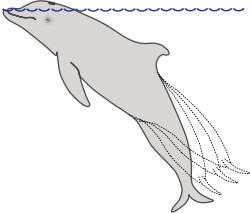Senses
Dolphins are often regarded as one of Earth's most intelligent animals, though it is hard to say just how intelligent. Comparing species' relative intelligence is complicated by differences in sensory apparatus, response modes, and nature of cognition. Furthermore, the difficulty and expense of experimental work with large aquatic animals has so far prevented some tests and limited sample size and rigor in others. Compared to many other species, however, dolphin behavior has been studied extensively, both in captivity and in the wild. See cetacean intelligence for more details.

Jumping and playing
Dolphins occasionally leap above the water surface, and sometimes perform acrobatic figures (for example, thespinner dolphin). Scientists are not certain about the purpose(s) of the acrobatics. Possibilities include locating schools of fish by looking at above-water signs like feeding birds, communicating with other dolphins, dislodging parasites or simple amusement.
Play is an important part of dolphin culture. Dolphins play with seaweed and play-fight with other dolphins. At times they harass other local creatures, like seabirds and turtles. Dolphins enjoy riding waves and frequently surf coastal swells and the bow waves of boats, at times “leaping” between the dual bow waves of a moving catamaran. Occasionally, they playfully interact with swimmers. Captive dolphins have been observed in aquariums engaging in complex play behavior which involves the creation and manipulation of bubble rings
Sleeping
 Generally, dolphins sleep with only one brain hemisphere in slow-wave sleep at a time, thus maintaining enough consciousness to breathe and to watch for possible predators and other threats. Earlier sleep stages can occur simultaneously in both hemispheres. In captivity, dolphins seemingly enter a fully asleep state where both eyes are closed and there is no response to mild external stimuli. In this case respiration is automatic; a tail kick reflexkeeps the blowhole above the water if necessary. Anesthetized dolphins initially show a tail kick reflex.Though a similar state has been observed with wild Sperm Whales, it is not known if dolphins in the wild reach this state. The Indus river dolphin has a different sleep method from other dolphin species. Living in water with strong currents and potentially dangerous floating debris, it must swim continuously to avoid injury. As a result, this species sleeps in very short bursts which last between 4 and 60 seconds
Generally, dolphins sleep with only one brain hemisphere in slow-wave sleep at a time, thus maintaining enough consciousness to breathe and to watch for possible predators and other threats. Earlier sleep stages can occur simultaneously in both hemispheres. In captivity, dolphins seemingly enter a fully asleep state where both eyes are closed and there is no response to mild external stimuli. In this case respiration is automatic; a tail kick reflexkeeps the blowhole above the water if necessary. Anesthetized dolphins initially show a tail kick reflex.Though a similar state has been observed with wild Sperm Whales, it is not known if dolphins in the wild reach this state. The Indus river dolphin has a different sleep method from other dolphin species. Living in water with strong currents and potentially dangerous floating debris, it must swim continuously to avoid injury. As a result, this species sleeps in very short bursts which last between 4 and 60 seconds